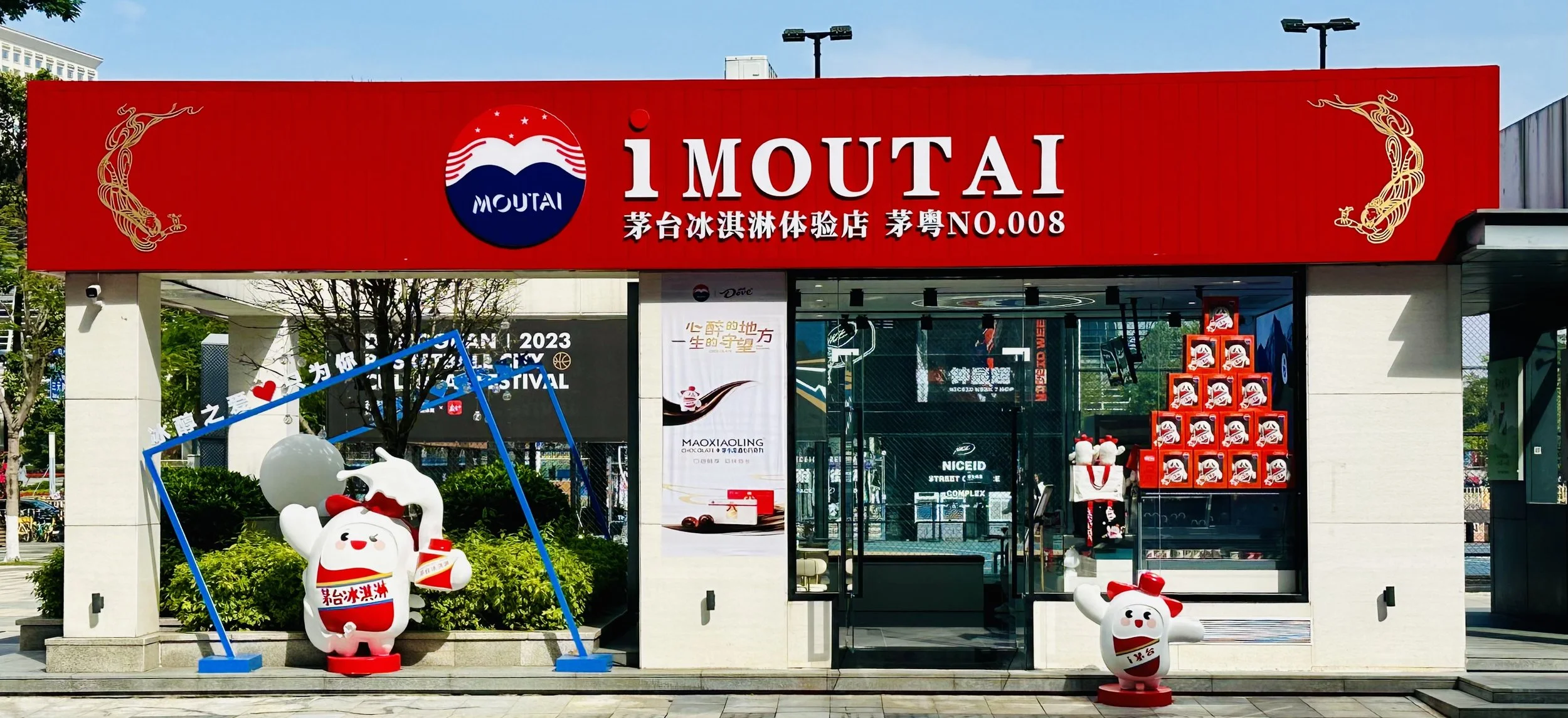A Simple Guide to Chinese Alcohol: Baijiu & Moutai
A store selling Moutai products in Dongguan in an attempt to attract a younger crowd of drinkers.
There is an assumption that the Chinese aren’t big drinkers. It might not be the same drinking culture as the UK (where is?), but craft beer bars are everywhere in Beijing; dim-lit whisky bars are dotted around the city and speakeasy cocktail bars are common. It’s not hard to find your favourite tipple in China, and if takes your fancy, there’s that other stuff: the mind-altering spirit that finds its way onto the table of every business-dinner negotiation in China: baijiu.
Chinese alcohol is largely unknown in the West. Even to me as a ex-restaurant manager, I was well-versed in wine, artisan spirits and sake, but had no clue about Chinese liquor until I moved here.
For those in the know, they might be aware of Moutai, both as a brand of baijiu and a place. In fact, Kweichow Moutai has been in the news over the last year or so as it marched to the number one spot as the largest spirit company in the world, ahead of LVMH and Diageo, which is even more impressive when you the understand that Diageo owns over 200 drinks brands, Moutai owns effectively just one.
But let’s step back a bit: we’re talking about baijiu. The literal translation is ‘white alcohol’ and is by far the most common liquor in China. Just like we have gin, vodka and tequila, in China there’s also baijiu. It’s made by distilling fermented sorghum, a old grain rarely used in the west. The end result is a potent spirit frequently 50% alcohol or higher. Within the category of baijiu are different styles of the spirit - erguotou from Beijing, wulianghe made from millet, maize or other grains, and moutai.
All moutai comes from the town of, yep, Moutai in Guizhou province. Apparently the terroir of the town is vital to moutai production. It has mild winters, hot summers, no extreme weather and a humid climate, which is all perfect for manufacturing and storing the spirit. There are around a thousand producers of moutai in the town, but for most drinkers, they only care about one: the state-owned Kweichow Moutai Company. However, the categorisation is a bit nuanced. Only moutai produced by Kweichow Moutai Company can be called ‘Moutai’, all other producers in the town must label theirs as Moutai Town Baijiu.
As we move into the Kweichow Moutai Company - producers of the most sought-after baijiu - classifications start to get even more complicated. There are seven grades of spirit within the company from low-end to high-end. The price between an entry-level bottle and a vintage bottle might be tens or hundreds of thousands of dollars difference. There are over a thousand different products under the umbrella of Moutai, but I’ll try to simplify it a tiny bit:
A bottle of Moutai
Low-End
At the lowest end there are six ‘brands’: the main two entry-level brands are Welcome (yingbin) and Prince (wangzi), alongside other ‘series’ products such as: lai mao, Guizhou daqu, hanjiang and renjiu. The addition of the term ‘series’ distinguishes these as low-end that cannot be simply be called Moutai. They need to be known as Moutai Series. These lower end bottles are affordable at a few hundred Renminbi per bottle. The low-end is usually categories into three grades (from low to high): Maotai Welcome Liquor, Maotai Prince Liquor and Maotai Series Liquor.
Mid-Level
Most people get interested at the mid-range level known as Flying Fairy (feitian) and Five Star (wuxing) - these two are identical alcohols, but the former was traditionally for the export market, and Five Star was for the domestic market (this is no longer the case). The alcohol in these bottles must be aged for a minimum of five years. Because Moutai continues to bottle age, older feitan can be expensive. On top of this, some bottles produced in particular years can have cultural or political significance - this does not effect the taste, but the price certainly can be high.
High-End
We then step into the realm of serious collectors. There are another three grades of Moutai here, moving up in price and rarity that all fall under the category of ‘Special Style’. Within each grade there can be a large number of different types.
Small-Batch Blending / Treasure - known as fine-tuned, these are bottles created in limited numbers for occasions or people. The most famous is the Zodiac series.
Special or Aged - These are quite rare, and often not available for purchase. They are made for specific events or people. Customised bottles such as the Great Hall of the People bottles fall under this category, produced exclusively for the government in Beijing (although this has apparently stopped now as a part of Xi’s crackdown on excess).
Vintage - Vintage does not refer to a specific year, like wine, but rather the age of the base wine which is blended with other newer alcohol. They are 15, 30, 50 and 80 vintages.
So to summarise from low price to high, we have:
Maotai Welcome Liquor
Maotai Prince Liquor
Maotai Series Liquor
Maotai Flying Fairy / Five Star
Small-Batch Blending / Treasure
‘Special’ Aged
Vintage
We then come to the thorn in the side of every successful company in China: knock-offs and fakes. Kweichow Moutai Company produces a limited number of bottles every year. And yet, number of bottles sold frequently out-pace this. There seems to be Moutai everywhere, which simply is impossible. This means fakes are common, and counterfeiters are sophisticated. Empty second-hand bottles can fetch a decent price and often make their way into the counterfeit market and then topped up with a combination of authentic and fake Moutai. Beyond this, many companies in Moutai town design their bottles to look remarkably similar to Kweichow Moutai Company’s bottles - using the same fonts, logos, wording and porcelain bottle. Technically not fake or illegal, it’s an easy mistake to make, picking up a bottle of Moutai Town liquor instead of the one you actually wanted.
All this counter-fitting and similar designed products, along with the complicated categorisation makes it hard for someone interested in Chinese liquor to even know where to start. Even if you read basic Chinese, it doesn’t necessarily make things easier. Even on Baidu (Chinese’s version of Google), there are heated debates over the correct classification of Moutai and a lot of contradictory information. Hopefully this guide will be a good little starter.



